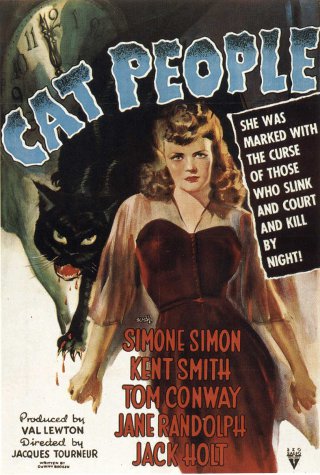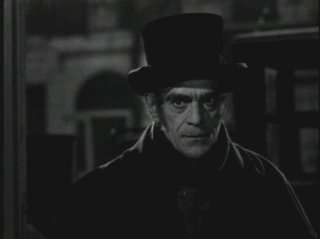In 1939, RKO-Radio Pictures was the smallest of the major studios. Its first ten years had been tumultuous, but things were looking up. They had just offered the talented youngster Orson Welles a multimillion dollar contract, hoping to capitalize on his success in their radio division. Welles’ first film was Citizen Kane, which opened to critical praise and has gone on to be frequently cited as the greatest film ever, but which also lost money for the studio at the time. In addition, Charles Foster Kane was obviously based on newspaper magnate William Randolph Hearst, who took the film none too kindly. In response to Welles’ hubris, Hearst’s media outlets boycotted the film, intimidated theaters into following suit, and threatened RKO exects with exposing fifteen years of suppressed Hollywood scandals. Welles’ second film, The Magnificent Ambersons was even less successful.
After some leadership shakeups, one of the ways RKO sought to reverse their fortunes was to focus on B movies, and specifical B horror movies. Enter Val Lewton, who was offered “artistic freedom” if he accepted a few conditions:
- He had to produce “horror programmers” with runtimes under 75 minutes.
- Each film had to come in under a $150,000 budget.
- Each film’s title would be determined by marketing research.
- Lewton’s salary would be $250 a week.
Lewton readily agreed, famously noting that “They may think I’m going to do the usual chiller stuff which’ll make a quick profit, be laughed at, and be forgotten, but I’m going to fool them . . . I’m going to do the kind of suspense movie I like.” And he certainly seemed to do so. There were no classical monsters in Lewton’s movies (the closest he came was with zombies, but those aren’t the Romero zombies we’re all too familiar with these days). They seemed unique and rather restrained. In today’s gore-happy world of Human Centipedes and Saws, they seem downright quaint, but they’re still very interesting.
- Cat People: RKO studio head Charles Koerner was apparently of the opinion that vampires, werewolves, and man-made monsters had been over-exploited and that “nobody has done much with cats.” Before Lewton even went to work, the title was chosen: Cat People. Lewton was apparently terrified of cats and drew on folk tales from his native Russia to make this film. The story concerns a Serbian girl, Irena (played by Simone Simon), who is convinced that she is cursed to turn into a panther and kill the man she loves. In theory, very similar to The Wolf Man (and other “enemy within” type stories), but in practice, a very strange yet well executed film.
There a number of effective sequences, including a nighttime chase sequence where the audible footsteps quickly dissapate, replaced by the quieter patter of a stalking cat. There’s also a tense sequence in a pool, and another in an office (where our heroic architect brandishes a T-square, which looks very much like a cross). There are some panthers in the film, but the action is usually shown in shadow – an effective choice. I don’t want to give the film too much credit, but it does prefigure a lot of what became known as the hallmarks of film noir. Many of the techniques in this film were used ad nauseam in the decade to follow. For instance, many of the scenes are framed in such a way that Irena is confined by shadows or other such shapes (for instance, at the zoo, the shadows of the zoo’s cages surround her), indicating that she is trapped by the curse of her people. This was replicated numerous times in film noir, using things like venetian shades to indicate the bars of confinement. Much of this is due to cinematographer Nicholas Musuraca, who was heavily influenced by German Expressionism and who helped refine the various noir techniques throughout the 1940s. Indeed, after launching Lewton’s first three films for RKO, director Jacques Tourneur moved out on his own, eventually teaming up with Masuraca again to produce one of the classic films noir, Out of the Past. Cat People is restrained, yet filled with lurid love triangles, repression, and vanity, all exacerbated by the supernatural folk tales of Serbia. The film was a big success, some saying that Cat People saved RKO, which was nearly bankrupted by Welles’ shenanigans at the time. It’s a tame film by today’s standards, but quite interesting nonetheless. ***
- Silver Bullet (Robot Chicken)
- The Leopard Man (trailer)
- Cat People (1982) (trailer)
- The Curse of the Cat People: The most intriguing thing about this sequel? There are no cats or panthers or pumas. Well, in the opening shot, there is a black house cat that scampers across the screen, but other than that, nothing. The title had been handed down from the studio’s marketing department, but Lewton, unphased, wrote a “very delicate story of a child who is on the verge of insanity because she lives in a fantasy world.” The film features much of the cast of the first film, including the… ghost?… of a cat woman. Despite the lack of cats, it turns out to be a very poetic and personal film about the fears and dangers of childhood. By 1944, RKO had moved Jacques Tourneur on to other things (their thinking being that splitting Lewton and Tourneur, they would get twice the output for the same price), so Lewton hired Gunther von Fritsch, whom he fired almost immediately because he was so slow (remember, these movies were made quickly and on a tight budget). In came a young Robert Wise, who would go on to direct classics like The Haunting and The Andromeda Strain (among many others). Once again, audiences were quite taken with the poetic and humane story presented in the film. It’s a very different film, practically unrelated to the original, but still quite effective in its own right. ***
- Full Moon Tonight (Robot Chicken)
- Isle of the Dead (trailer)
- The Seventh Victim (trailer)
- I Walked With a Zombie: I actually watched these films a bit out of order, as this was the second of Lewton’s productions, also directed by Jacques Tourneur. A recurring theme of Lewton’s work seemed to be his exasperation at the titles he was handed from the marketing department. In this case, he was quite distraught until he came up with the idea to simply adapt one of his favorite books. He described this movie as “Jane Eyre in the West Indies.” With zombies. (Note, this was 60-70 years before Pride and Prejudice and Zombies, and the numerous mashups that followed). Not being that familiar with Jane Eyre, I can’t say as to how successful Lewton was in terms of adaptation, but the film itself is pretty damn good. There are several standout sequences, my favorite being when two women, dressed in white, navigate through a dark field towards the distant drums of a voodoo ceremony (which are, in themselves, a wonderfully atmospheric touch). Ultimately, I didn’t find this as enjoyable as the two Cat People movies, but it was an interesting watch nonetheless. **1/2
- The Simpsons: Treehouse of Horror III: Dial “Z” for Zombies (sorry, no clips online)
- Ghost Ship (trailer)
- I Sell the Dead (trailer)
- The Body Snatcher: Another Robert Wise film, this time based on the short story The Body Snatcher by Robert Louis Stevenson. Here Lewton was relieved by the good title and the classic source material (which also happened to be in the public domain), though exasperation came later when the initial script, which had introduced much more mayhem than Stevenson’s original story called for. Lewton himself rewrote the script at the last moment, making sure that the film still appealed to stars Boris Karloff and even the ailing Bela Legosi. Well, whatever his worries, the film turned out fantastic. Wise and Lewton relished being able to create a period piece that could still be filmed cheaply. Legosi was very ill at the time, so he was not quite up to speed, but luckily, he played a rather small part as the mad scientist’s half-wit assistant, so his infirmities were actually appropriate for the role. Karloff was at the top of his game though, delivering the sharp dialogue with gusto.
The story concerns a doctor (played by Henry Daniell) who requires fresh cadavers in order to continue his studies and teach his students. The law being somewhat in opposition to this practice, he had to hire an insolent cab-man (Karloff) to rob the graves of the recently deceased. When there are not enough bodies to meet the doctor’s needs, the cab-man resorts to murder! It’s all very well done, the relationship between the doctor and the cabby gradually escalates with tension, and Karloff and Daniell clearly got under each other’s skin. The film reaches its climax with Karloff delivering a wonderful monologue: “I am a small man, a humble man, and, being poor, I have had to do much that I did not want to do. But so long as the great Dr. MacFarlane jumps at my whistle, that long am I a man. And if I have not that, I have nothing.” Karloff’s performance is something to behold. Having spent most of his career playing various monsters, Karloff clearly relished playing a human being, even if the character was a manipulative villain. In today’s parlance, he’s just chewing the scenery. Playing opposite Karloff was the capable Henry Daniell, who certainly holds his own as the conflicted and guilty doctor, ashamed of his past and perhaps even his future. Once again, while perhaps a bit grisly for its time, this is tame by today’s standards… but it’s definitely worth watching for Karloff’s performance alone. ***
Ah, it’s good to be back in the flow of traditional 6WH posts. Stay tuned for some quick reviews of the Fear Itself anthology series and I think I’ll end up covering three Wes Craven movies next week. Recommendations are always welcome, though I can’t guarantee I’ll get to it (but if it’s available on Netflix streaming or Amazon Prime’s free streaming, I’ll probably give it a shot).


Welles’ second film, The Magnificent Ambersons. was even less successful.
And if RKO hadn’t edited it with a battleaxe, it would have been a better film that CK. It’s already a helluva movie.
I have not seen it, but it is one of those holy grail lost movies that I’d love to see the original version of. I guess I should watch it as it is now, but I still hold out hope that someone will find one of the original prints and sell it to Criterion or something.
All that being said, from what I understand, it wouldn’t have been much of a commercial success (even if it did become a critical success)…